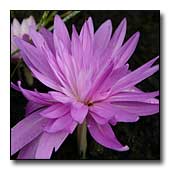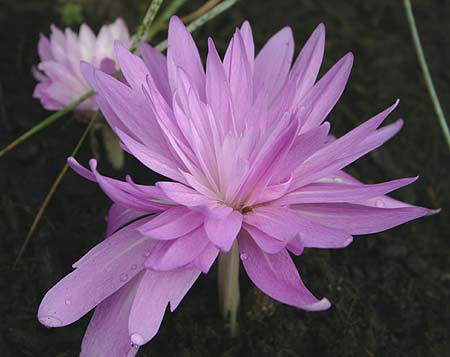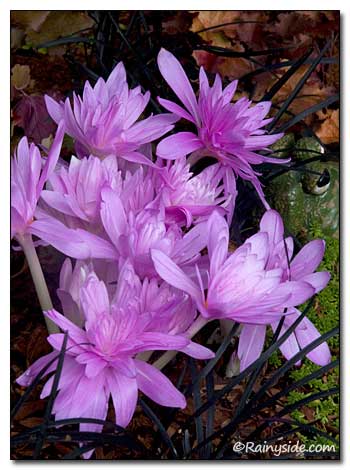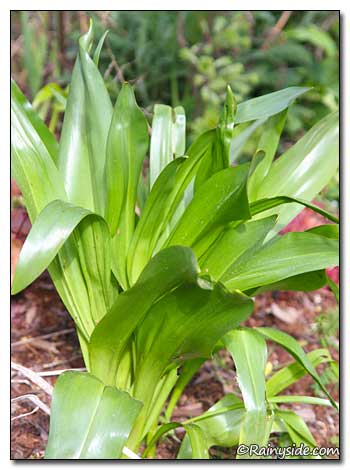Colchicum 'Water Lily'
AUTUMN CROCUS
Family: Liliaceae
Pronounced: KOHL-chi-kum

Quick Jumps
Growing Guide
Rainy Side Notes
GROWING GUIDE

Origin:
Garden.
Plant Group:
Bulbs.
Hardiness:
Sunset zones: 2-10, 14-24.
USDA zones: 4-9.
Mature size:
Height: 5 inches (13 cm).
Flowering period:
Autumn.
Flowering attributes:
Lavender-pink, fully double flowers.
Leaf attributes:
Seven to ten-inch long, narrowly ovate leaves.
Light:
Full sun.
Soil:
Deep, humus rich, moist, well-drained soil.
Feeding:
Fertilize at planting time and in the spring, with a complete organic fertilizer.
Propagation Methods:
Dig up and separate corms in summer and replant.
Pests and Diseases:
Gray mold and slugs may be a problem, although neither has troubled my plants.
Rainy Side Notes


It wouldn't be fall in my garden without the stunning flowers of Colchicum 'Water Lily' pushing its blossoms out of the soil. Often called autumn crocus, colchicums are not true crocus, but members of the lily family—Liliaceae. In spring, the plants deliver up seven to ten-inch long, narrowly ovate leaves that remain in the garden, feeding the bulb, until July. Later, in early fall, the ample double, lavender-pink flower at the end of a leafless stalk opens, creating a striking floral scene that lasts for weeks in the autumn garden.
This colchicum cultivar came to my garden from a generous gardening friend, who dug up the whole plant while in bloom and separated the bulbs. Digging them while they are flowering or in leaf is not a recommended practice; however, she knew how to handle this without harming them, and now I have plenty in the garden. For others, without her magic touch, and myself, divide the bulbs while they are dormant.
Commercially used as a pharmaceutical drug, all parts of colchicums are toxic to humans as well as animals, especially the bulbs and seeds. They contain an alkaloid, colchicine, which affects the nervous system and can cause kidney damage, along with convulsions, paralysis, coma and death. Use gloves when handling, as contact with the corms may cause skin irritation.
Dioscorides (50-79 A.D.) used an extract from the species leaves Colchicum autumnale, soaked in wine, to "dissolve tumors and growth." Pliny (23-79 A.D.) and Ibn Sina (980-1037) A.D.) believed the concoction worked; however, others such as Galen (129-210 A.D.) did not. Still others thought of it as a poison, because of its side affects—nausea, vomiting, lack of appetite and hair loss. In modern medicine, it is now known that colchicine is highly effective against certain malignancies. Colchicums are also used in plant genetics to double chromosomes.
Plant out colchicums three inches deep and six to eight inches apart, as soon as they arrive and before they bloom. When the leaves come up in spring, it is important to allow them to remain intact until they die back to the ground. Cutting the leaves back too soon will rob the bulbs of needed nutrients. Lift and divide while dormant, every three to four years, before they become over-crowded.
Photographed in author's garden.
A Pacific Northwest Plant of the Week (2013)

Gardening for the Homebrewer: Grow and Process Plants for Making Beer, Wine, Gruit, Cider, Perry, and More
By co-authors Debbie Teashon (Rainy Side Gardeners) and Wendy Tweton
Copyright Notice | Home | Search | Bulbs

